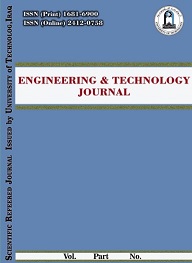Abstract
Machining of electrically non-conducting materials like glass is still a major
problem. The principle of electric arc was used to generate high electrical discharge
(spark) at high currents to machine non-conducting materials at any hardness, which
is a new approach.
EDM system was build for machining of non-conducting cutting materials such
as glass with new technology including the use of powder (graphite) mixed for
dielectric solution (tap water) by supplied AC current values (200, 250, 300, 350 and
400A). Voltage of (70V) was used to cut 3mm thickness of borosilicate glass (BSG)
to obtain the average surface roughness (Ra) of about (0.003-0.012μm) but the Ra
before the machining was (0.005-0.006μm).
Numerical program called "Simulent" has been used to investigate the process
control for EDM by using GN, BPN, PN and VQN that could predict the Ra with
accuracies of 94.236, 94.034, 96.628 and 92.875% respectively from training data
sets.
The differences on the Ra at different network models for 3mm thickness of BSG
never exceed (8%) from testing data sets while the comparison of numerical results
with experimental results of Ra among the measured values and prediction various
network models, shows a differences between (1-8%).
The best predication accuracy is by the use of PN than other network models
problem. The principle of electric arc was used to generate high electrical discharge
(spark) at high currents to machine non-conducting materials at any hardness, which
is a new approach.
EDM system was build for machining of non-conducting cutting materials such
as glass with new technology including the use of powder (graphite) mixed for
dielectric solution (tap water) by supplied AC current values (200, 250, 300, 350 and
400A). Voltage of (70V) was used to cut 3mm thickness of borosilicate glass (BSG)
to obtain the average surface roughness (Ra) of about (0.003-0.012μm) but the Ra
before the machining was (0.005-0.006μm).
Numerical program called "Simulent" has been used to investigate the process
control for EDM by using GN, BPN, PN and VQN that could predict the Ra with
accuracies of 94.236, 94.034, 96.628 and 92.875% respectively from training data
sets.
The differences on the Ra at different network models for 3mm thickness of BSG
never exceed (8%) from testing data sets while the comparison of numerical results
with experimental results of Ra among the measured values and prediction various
network models, shows a differences between (1-8%).
The best predication accuracy is by the use of PN than other network models
